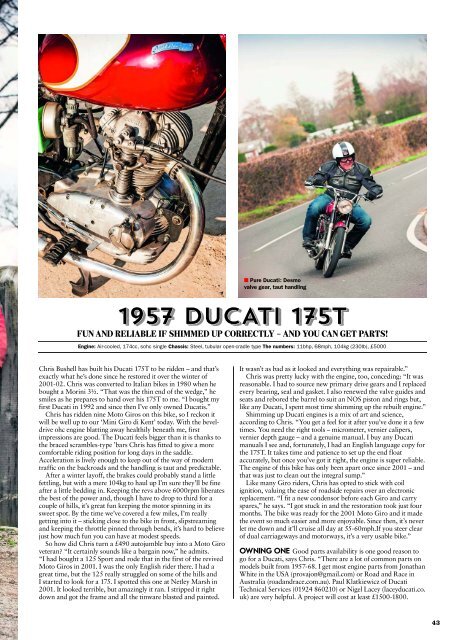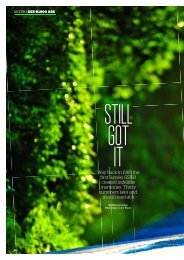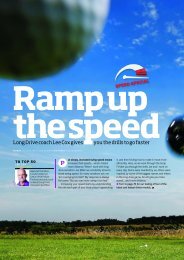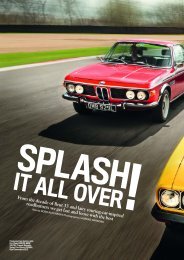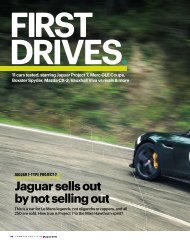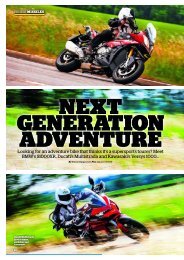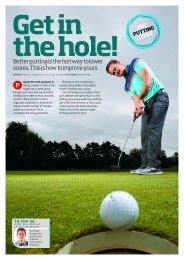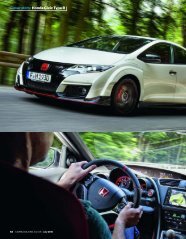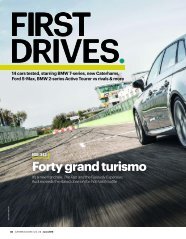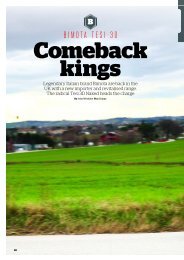Create successful ePaper yourself
Turn your PDF publications into a flip-book with our unique Google optimized e-Paper software.
Q Pure Ducati: Desmo<br />
valve gear, taut handling<br />
1957 DUCATI 175T<br />
FUN AND RELIABLE IF SHIMMED UP CORRECTLY – AND YOU CAN GET PARTS!<br />
Engine: Air-cooled, 174cc, sohc single Chassis: Steel, tubular open-cradle type The numbers: 11bhp, 68mph, 104kg (230lb), £5000<br />
Chris Bushell has built his Ducati 175T to be ridden – and that’s<br />
exactly what he’s done since he restored it over the winter of<br />
2001-02. Chris was converted to Italian bikes in 1980 when he<br />
bought a Morini 3½. “That was the thin end of the wedge,” he<br />
smiles as he prepares to hand over his 175T to me. “I bought my<br />
first Ducati in 1992 and since then I’ve only owned Ducatis.”<br />
Chris has ridden nine Moto Giros on this bike, so I reckon it<br />
will be well up to our ‘Mini Giro di Kent’ today. With the beveldrive<br />
ohc engine blatting away healthily beneath me, first<br />
impressions are good. The Ducati feels bigger than it is thanks to<br />
the braced scrambles-type ’bars Chris has fitted to give a more<br />
comfortable riding position for long days in the saddle.<br />
Acceleration is lively enough to keep out of the way of modern<br />
traffic on the backroads and the handling is taut and predictable.<br />
After a winter layoff, the brakes could probably stand a little<br />
fettling, but with a mere 104kg to haul up I’m sure they’ll be fine<br />
after a little bedding in. Keeping the revs above 6000rpm liberates<br />
the best of the power and, though I have to drop to third for a<br />
couple of hills, it’s great fun keeping the motor spinning in its<br />
sweet spot. By the time we’ve covered a few miles, I’m really<br />
getting into it – sticking close to the bike in front, slipstreaming<br />
and keeping the throttle pinned through bends, it’s hard to believe<br />
just how much fun you can have at modest speeds.<br />
So how did Chris turn a £490 autojumble buy into a Moto Giro<br />
veteran? “It certainly sounds like a bargain now,” he admits.<br />
“I had bought a 125 Sport and rode that in the first of the revived<br />
Moto Giros in 2001. I was the only English rider there. I had a<br />
great time, but the 125 really struggled on some of the hills and<br />
I started to look for a 175. I spotted this one at Netley Marsh in<br />
2001. It looked terrible, but amazingly it ran. I stripped it right<br />
down and got the frame and all the tinware blasted and painted.<br />
It wasn’t as bad as it looked and everything was repairable.”<br />
Chris was pretty lucky with the engine, too, conceding: “It was<br />
reasonable. I had to source new primary drive gears and I replaced<br />
every bearing, seal and gasket. I also renewed the valve guides and<br />
seats and rebored the barrel to suit an NOS piston and rings but,<br />
like any Ducati, I spent most time shimming up the rebuilt engine.”<br />
Shimming up Ducati engines is a mix of art and science,<br />
according to Chris. “You get a feel for it after you’ve done it a few<br />
times. You need the right tools – micrometer, vernier calipers,<br />
vernier depth gauge – and a genuine manual. I buy any Ducati<br />
manuals I see and, fortunately, I had an English language copy for<br />
the 175T. It takes time and patience to set up the end float<br />
accurately, but once you’ve got it right, the engine is super reliable.<br />
The engine of this bike has only been apart once since 2001 – and<br />
that was just to clean out the integral sump.”<br />
Like many Giro riders, Chris has opted to stick with coil<br />
ignition, valuing the ease of roadside repairs over an electronic<br />
replacement. “I fit a new condensor before each Giro and carry<br />
spares,” he says. “I got stuck in and the restoration took just four<br />
months. The bike was ready for the 2001 Moto Giro and it made<br />
the event so much easier and more enjoyable. Since then, it’s never<br />
let me down and it’ll cruise all day at 55-60mph.If you steer clear<br />
of dual carriageways and motorways, it’s a very usable bike.”<br />
OWNING ONE: Good parts availability is one good reason to<br />
go for a Ducati, says Chris. “There are a lot of common parts on<br />
models built from 1957-68. I get most engine parts from Jonathan<br />
White in the USA (provajon@gmail.com) or Road and Race in<br />
Australia (roadandrace.com.au). Paul Klatkiewicz of Ducati<br />
Technical Services (01924 860210) or Nigel Lacey (laceyducati.co.<br />
uk) are very helpful. A project will cost at least £1500-1800.<br />
43


